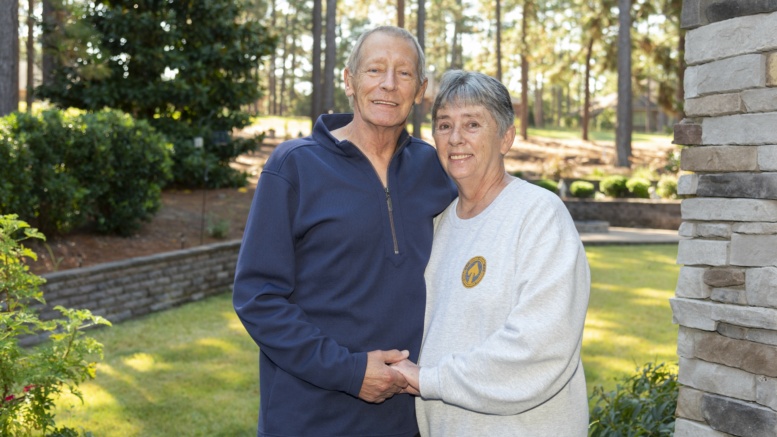Ignoring medical symptoms is common, especially for men, but Raymond Pimpare is hoping his story will inspire others to do just the opposite.
In 2019, the Pinehurst resident said he had a feeling something was wrong.
Pimpare wasted little time visiting his family medicine physician, Marshall Nickel, M.D., to try to determine the cause. He didn’t know how to pinpoint the issue, but he knew it needed to be checked by his physician.
“I knew something was wrong,” Pimpare said. “I had been smoking since I was 9 years old – about 60 years.”
Pimpare had lung cancer screening through a low-dose CT scan and was diagnosed soon after with small-cell lung cancer. Pimpare quit smoking right away, and a team of FirstHealth experts began working on a treatment plan to address his cancer.
“At the beginning, Ray wanted to have the lung removed,” Dottie Pimpare, his wife, said. “It’s not that simple. Taking some of his lung would reduce his lung capacity, and his lungs are compromised anyway. The doctors decided that Ray should go with radiation and chemo. They were phenomenal.”
Michael Pritchett, D.O., medical director of the Chest Center of the Carolinas, said Pimpare’s cancer was very small and found early, allowing his care team to treat it with chemotherapy and radiation therapy.
“What was unique about Ray’s case was that this was small-cell lung cancer, which is only very rarely found at such an early stage. Usually, we find this type of cancer once it has spread to the lymph nodes or even outside the chest,” Pritchett said.
Pimpare was also the 49th patient at FirstHealth to receive a biopsy with the Ion robotic navigation platform. The robotic technology allowed his doctors to biopsy the very small spot on his lungs, something that would have been impossible with any other method.
Pritchett said Pimpare’s outlook is good.
“These cancers can certainly come back, but that’s usually when we see much more extensive involvement. Ray’s cancer was smaller than the size of a dime, so we hope the aggressive treatment will offer him a long-term cure,” Pritchett said. “We will do ongoing CT scans every six months for two years and then annually after that to ensure that we aren’t missing any recurrence.”
While Ray is quick to point out the work of his care team, Pritchett said his story is one that highlights the importance of early detection.
“Ray was absolutely saved by lung cancer screening,” Pritchett said. “About 75% of lung cancers are found at Stage 3 or 4, and the prognosis is usually much worse. Overall, the five-year survival rate for all patients combined that have lung cancer (all stages together) is about 20%. But when we can catch it early, then that number gets closer to 80% for five-year survival. It’s absolutely critical to catch these early.”
Lung cancer (both small cell and non-small cell) is the second most common cancer in both men and women and by far the leading cause of cancer death among both men and women, making up almost 25% of cancer deaths. Each year, more people die of lung cancer than of colon, breast and prostate cancers combined.
The American Cancer Society estimates than 2020 about 228,820 new cases of lung cancer will be diagnosed. Lung cancer mainly occurs in older people. Most people diagnosed with lung cancer are 65 or older; a very small number of people diagnosed are younger than 45.
Despite the statistics, the number of new lung cancer cases continues to decrease, partly because fewer people are smoking. Also, the number of deaths from lung cancer continues to drop due to advances in early detection and treatment.
Throughout his treatment and since, Ray said he and his wife are staying positive, thankful to still be together and enjoying their retirement.
“Glass half full all the way. We are going to stay strong to live long,” he said.










